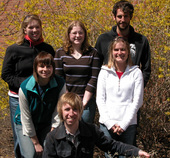Highlight
A Problem-Solving Practicum: Managing Oak Wilt
Achievement/Results
Our education and training program on Risk Analysis for Introduced Species and Genotypes links research to applications of ecological risk analysis. Much of the curriculum gives students foundational knowledge and skills in risk analysis. In a particularly unique 15-week course, which we call a problem-solving practicum, students apply that knowledge to dilemmas faced by our external partners. Students work with faculty and external partners to identify researchable questions which, if answered, would help to resolve real-world challenges. Faculty members ensure an integration of ideas from the social and natural sciences.
This year, the problem solving practicum focused on oak wilt, a disease caused by the fungus Ceratocystis fagacearum. The pathogen is an exotic-invasive species and is the most serious threat to red oaks, Quercus spp. Section Lobatae, in the eastern United States. The pathogen continues to spread in Minnesota and annually kills thousands of trees. In response, the Minnesota Department of Natural Resources (MN-DNR), in cooperation with the USDA Forest Service, has implemented a risk management program to fund local government action aimed at containing oak wilt and preserving existing oak trees. Nevertheless, oak wilt continues to spread. Both agencies partnered with our NSF-funded IGERT (Integrative Graduate Education and Research Traineeship) program to better understand factors that may affect the performance of their risk management program.
The course was led by Frances Homans, Department of Applied Economics, and supported by Rob Venette, Research Biologist, USDA Forest Service and adjunct faculty member in the Department of Entomology, and Bob Haight, Economist, USDA Forest Service and adjunct professor of Forest Resources. With guidance from these instructors, the six IGERT students identified three questions for coordinated research. First, how effective are current treatments options supported by the state management program? Second, do local land managers consider oak wilt a priority relative to other forest threats? Third, how do institutional and social factors affect local governmental capacity for management?
Data are still being analyzed, but early results have received much attention. Initial findings suggest that treatment success can be highly variable, but aggressive treatments can be >80% effective in preventing detectable spread of the pathogen. Our students have also discovered that managers responsible for state and community properties differ considerably in their perceptions about oak wilt and the need for management; not everyone considers oak wilt a priority threat. From interviews with city foresters, our students learned that management is affected by city and state funding, and existence and enforcement of diseased-tree removal ordinances.
This educational opportunity has led to a number of tangible products. An interim report summarizing the statistical analysis of treatment methods for oak wilt was shared with the MN-DNR. The students who contributed to the report were commended. The summary was highly informative to the state. Subsequently, the agency distributed this report to oak wilt managers and researchers in Michigan, Wisconsin, Texas, and Colorado because the information was judged credible and highly useful. Students have also prepared a research poster to share results with other scientists. In the upcoming weeks, a white paper will be produced for the Forest Service and the MN-DNR to provide a greater description of results to date. At least one other presentation at a professional conference and one peer-reviewed publication are envisioned. All information will be presented to our stakeholders for consideration in future changes to the oak wilt management program.
A particularly unique dimension of this course is the extent of professional development that has occurred. Students made formal contact with leading national and regional scientists who are working to better understand and manage many invasive species, including oak wilt. They also established contact with local land managers during interviews. To prepare for these interviews, students integrated knowledge from other courses with information obtained during the class. As the projects unfolded, student teams mutually reinforced each other. For example, perceptions about the need for oak wilt management are influenced, in part, by the perceived efficacy of available treatment options. Our results highlight the utility of combining natural and social science methodologies in the study of ecological risk analysis.
We would like to extend a special thanks to Susan Burks, Val Cervenka, and Ed Hayes with the Minnesota Department of Natural Resources, Jill Pokorny and Jennifer Juzwik with USDA Forest Service, and the numerous individuals who met with the students to share their opinions and experiences about oak wilt. These interactions enriched the educational experience.
The University of Minnesota Risk Analysis for Introduced Species and Genotypes IGERT comprises a diverse group of faculty and external partners led by Ray Newman, David Andow, Susan Galatowitsch, Anne Kapuscinski and Ruth Shaw.
Address Goals
To take on a project as part of a world-class, broadly inclusive scientific discipline and to expand the literacy of all citizens, one must be able to step back from a problem and view the broader “landscape.”
Our primary goal was achieved by presenting students with a problem that required them to step back from the science and assess other factors that might be contributing to the problem. Through discussion and literature research students identified the need to combine disciplines in order to recommend improvements for oak wilt management. In other words, they learned that oak wilt is not just a plant pathology problem; it may also be a sociological problem.
The course served as the base from which all participants learned how to identify research areas of both greatest opportunity and potential benefit, regardless of their own individual expertise.
Rather than remaining in a laboratory setting to devise the best possible oak-wilt fungicide, they integrated their new, multidisciplinary knowledge and spread out across disciplines to move toward their goal of improved oak-wilt management.
Much like skilled soccer players, it is not useful to have all team-members working at the same spot to move the ball to the goal. To win, team members spread out across the entire field, work in concert, and score.






